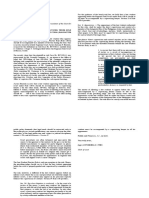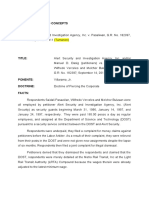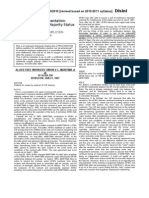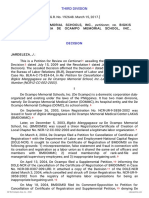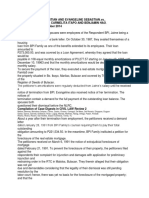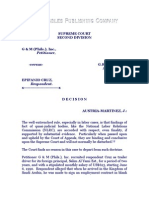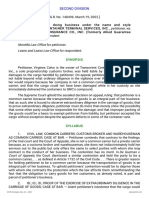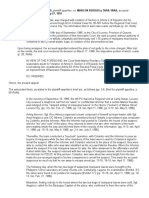0 ratings0% found this document useful (0 votes)
130 viewsCirtek Employees Vs Cirtek Electronics
Cirtek Employees Vs Cirtek Electronics
Uploaded by
Marefel Anora1. A Memorandum of Agreement (MOA) was entered into in 2005 between Cirtek Electronics and its employee union regarding wages and benefits.
2. The union filed a petition challenging the validity of the MOA, which was granted by the Secretary of Labor. However, the Court of Appeals ruled in favor of giving credence to the MOA.
3. The Supreme Court denied the motion for reconsideration, finding that the Secretary of Labor acted within his jurisdiction to impose higher wage increases than what was in the MOA, based on factors like the company's financial documents and bargaining history.
Copyright:
© All Rights Reserved
Available Formats
Download as DOCX, PDF, TXT or read online from Scribd
Cirtek Employees Vs Cirtek Electronics
Cirtek Employees Vs Cirtek Electronics
Uploaded by
Marefel Anora0 ratings0% found this document useful (0 votes)
130 views6 pages1. A Memorandum of Agreement (MOA) was entered into in 2005 between Cirtek Electronics and its employee union regarding wages and benefits.
2. The union filed a petition challenging the validity of the MOA, which was granted by the Secretary of Labor. However, the Court of Appeals ruled in favor of giving credence to the MOA.
3. The Supreme Court denied the motion for reconsideration, finding that the Secretary of Labor acted within his jurisdiction to impose higher wage increases than what was in the MOA, based on factors like the company's financial documents and bargaining history.
Original Title
13. Cirtek Employees vs Cirtek Electronics.docx
Copyright
© © All Rights Reserved
Available Formats
DOCX, PDF, TXT or read online from Scribd
Share this document
Did you find this document useful?
Is this content inappropriate?
1. A Memorandum of Agreement (MOA) was entered into in 2005 between Cirtek Electronics and its employee union regarding wages and benefits.
2. The union filed a petition challenging the validity of the MOA, which was granted by the Secretary of Labor. However, the Court of Appeals ruled in favor of giving credence to the MOA.
3. The Supreme Court denied the motion for reconsideration, finding that the Secretary of Labor acted within his jurisdiction to impose higher wage increases than what was in the MOA, based on factors like the company's financial documents and bargaining history.
Copyright:
© All Rights Reserved
Available Formats
Download as DOCX, PDF, TXT or read online from Scribd
Download as docx, pdf, or txt
0 ratings0% found this document useful (0 votes)
130 views6 pagesCirtek Employees Vs Cirtek Electronics
Cirtek Employees Vs Cirtek Electronics
Uploaded by
Marefel Anora1. A Memorandum of Agreement (MOA) was entered into in 2005 between Cirtek Electronics and its employee union regarding wages and benefits.
2. The union filed a petition challenging the validity of the MOA, which was granted by the Secretary of Labor. However, the Court of Appeals ruled in favor of giving credence to the MOA.
3. The Supreme Court denied the motion for reconsideration, finding that the Secretary of Labor acted within his jurisdiction to impose higher wage increases than what was in the MOA, based on factors like the company's financial documents and bargaining history.
Copyright:
© All Rights Reserved
Available Formats
Download as DOCX, PDF, TXT or read online from Scribd
Download as docx, pdf, or txt
You are on page 1of 6
G.R. No.
190515 June 6, 2011
CIRTEK EMPLOYEES LABOR UNION-
FEDERATION OF FREE WORKERS Petitioner,
vs.
CIRTEK ELECTRONICS, INC., Respondent.
FACTS
On August 24, 2005, a Memorandum of Agreement (MOA)
was entered into between Cirtek Electronics and Cirtek
Employees Labor Union Federation of Free Workers.
A motion for reconsideration and supplemental motion for
reconsideration was filed by respondent, Cirtek Electronics,
Inc., of the Court’s Decision dated November 15, 2010.
Cirtek Electronics avers that petitioner Cirtek Employees
Labor Union Federation of Free Workers, in filing the
petition for certiorari under Rule 65, availed of the wrong
remedy, hence, the Court should have dismissed the
petition outright. It goes on to aver that the Court erred in
resolving a factual issue – whether the August 24, 2005
Memorandum of Agreement (MOA) was validly entered
into –, which is not the office of a petition for certiorari.
Respondent-movant further avers that the MOA1 signed by
the remaining officers of petitioner Union and allegedly
ratified by its members should have been given credence by
the Court.
Furthermore, respondent-movant maintains that the
Secretary of Labor cannot insist on a ruling beyond the
compromise agreement entered into by the parties; and that,
as early as February 5, 2010, petitioner Union had already
filed with the Department of Labor and Employment
(DOLE) a resolution of disaffiliation from the Federation of
Free Workers resulting in the latter’s lack of personality to
represent the workers in the present case.
The motion is bereft of merit.
Respondent indeed availed of the wrong remedy of
certiorari under Rule 65. Due, however, to the nature of the
case, one involving workers’ wages and benefits, and the
fact that whether the petition was filed under Rule 65 or
appeal by certiorari under Rule 45 it was filed within 15
days (the reglementary period under Rule 45) from
petitioner’s receipt of the resolution of the Court of
Appeals’ Resolution denying its motion for
reconsideration, the Court resolved to give it due course.
As Almelor v. RTC of Las Piñas, et al. 2 restates:
Generally, an appeal taken either to the Supreme Court or
the CA by the wrong or inappropriate mode shall be
dismissed. This is to prevent the party from benefiting from
one’s neglect and mistakes. However, like most rules, it
carries certain exceptions. After all, the ultimate purpose
of all rules of procedures is to achieve substantial justice as
expeditiously as possible. (emphasis and underscoring
supplied)
Respecting the attribution of error to the Court in ruling on
a question of fact, it bears recalling that a QUESTION OF
FACT arises when the doubt or difference arises as to the
truth or falsehood of alleged facts,3 while a QUESTION OF
LAW exists when the doubt or difference arises as to what
the law is on a certain set of facts.
Ineluctably, the issue involves a determination and
application of existing law, the provisions of the Labor
Code, and prevailing jurisprudence. Intertwined with the
issue, however, is the question of validity of the MOA and
its ratification which, as movant correctly points out, is a
question of fact and one which is not appropriate for a
petition for review on certiorari under Rule 45. The rule,
however, is not without exceptions, viz:
This rule provides that the parties may raise only questions
of law, because the Supreme Court is not a trier of facts.
Generally, we are not duty-bound to analyze again and
weigh the evidence introduced in and considered by the
tribunals below. When supported by substantial evidence,
the findings of fact of the CA are conclusive and binding
on the parties and are not reviewable by this Court, unless
the case falls under any of the following recognized
exceptions:
(1) When the conclusion is a finding grounded
entirely on speculation, surmises and conjectures;
(2) When the inference made is manifestly mistaken,
absurd or impossible;
(3) Where there is a grave abuse of discretion;
(4) When the judgment is based on a
misapprehension of facts;
(5) When the findings of fact are conflicting;
(6) When the Court of Appeals, in making its
findings, went beyond the issues of the case and the
same is contrary to the admissions of both appellant
and appellee;
(7) When the findings are contrary to those of the
trial court;
(8) When the findings of fact are conclusions
without citation of specific evidence on which they
are based;
(9) When the facts set forth in the petition as well as
in the petitioners' main and reply briefs are not
disputed by the respondents; and
(10) When the findings of fact of the Court of
Appeals are premised on the supposed absence of
evidence and contradicted by the evidence on record.
(emphasis and underscoring supplied)
In the present case, the findings of the Secretary of Labor
and the appellate court on whether the MOA is valid and
binding are conflicting, the former giving scant
consideration thereon, and the latter affording it more
weight.
As found by the Secretary of Labor, the MOA came about
as a result of the constitution, at respondent’s behest, of the
Labor-Management Council (LMC) which, he reminded
the parties, should not be used as an avenue for bargaining
but for the purpose of affording workers to participate in
policy and decision-making. Hence, the agreements
embodied in the MOA were not the proper subject of the
LMC deliberation or procedure but of CBA negotiations
and, therefore, deserving little weight.
The appellate court, held, however, that the Secretary did
not have the authority to give an arbitral award higher than
what was stated in the MOA. The conflicting views drew
the Court to re-evaluate the facts as borne by the records,
an exception to the rule that only questions of law may be
dealt with in an appeal by certiorari under Rule 45.
As discussed in the Decision under reconsideration, the
then Acting Secretary of Labor Manuel G. Imson acted
well within his jurisdiction in ruling that the wage increases
to be given are ₱10 per day effective January 1, 2004 and
₱15 per day effective January 1, 2005, pursuant to his
power to assume jurisdiction under Art. 263 (g)4 of the
Labor Code.
While an arbitral award cannot per se be categorized as an
agreement voluntarily entered into by the parties because it
requires the interference and imposing power of the State
thru the Secretary of Labor when he assumes jurisdiction,
the award can be considered as an approximation of a
collective bargaining agreement which would otherwise
have been entered into by the parties. Hence, it has the
force and effect of a valid contract obligation between the
parties.5
In determining arbitral awards then, aside from the MOA,
courts considered other factors and documents including, as
in this case, the financial documents6 submitted by
respondent as well as its previous bargaining history and
financial outlook and improvements as stated in its own
website.7
The appellate court’s ruling that giving credence to the
"Pahayag" and the minutes of the meeting which were not
verified and notarized would violate the rule on parol
evidence is erroneous. The parol evidence rule, like other
rules on evidence, should not be strictly applied in labor
cases. Interphil Laboratories Employees Union-FFW v.
Interphil Laboratories, Inc. 8 teaches:
[R]eliance on the parol evidence rule is misplaced. In labor
cases pending before the Commission or the Labor Arbiter,
the rules of evidence prevailing in courts of law or equity
are not controlling. Rules of procedure and evidence are not
applied in a very rigid and technical sense in labor cases.
Hence, the Labor Arbiter is not precluded from accepting
and evaluating evidence other than, and even contrary to,
what is stated in the CBA. (emphasis and underscoring
supplied)
On the contention that the MOA should have been given
credence because it was validly entered into by the parties,
the Court notes that even those who signed it expressed
reservations thereto. A CBA (assuming in this case that the
MOA can be treated as one) is a contract imbued with
public interest. It must thus be given a liberal, practical and
realistic, rather than a narrow and technical construction,
with due consideration to the context in which it is
negotiated and the purpose for which it is intended.9
As for the contention that the alleged disaffiliation of the
Union from the FFW during the pendency of the case
resulted in the FFW losing its personality to represent the
Union, the same does not affect the Court’s upholding of
the authority of the Secretary of Labor to impose arbitral
awards higher than what was supposedly agreed upon in
the MOA. Contrary to respondent’s assertion, the
"unavoidable issue of disaffiliation" bears no significant
legal repercussions to warrant the reversal of the Court’s
Decision.
En passant, whether there was a valid disaffiliation is a
factual issue. Besides, the alleged disaffiliation of the
Union from the FFW was by virtue of a Resolution signed
on February 23, 2010 and submitted to the DOLE Laguna
Field Office on March 5, 2010 – two months after the
present petition was filed on December 22, 2009, – hence,
it did not affect FFW and its Legal Center’s standing to file
the petition nor this Court’s jurisdiction to resolve the
same.
At all events, the issue of disaffiliation is an intra-union
dispute which must be resolved in a different forum in an
action at the instance of either or both the FFW and the
Union or a rival labor organization, not the employer.
An intra-union dispute refers to any conflict between and
among union members, including grievances arising from
any violation of the rights and conditions of membership,
violation of or disagreement over any provision of the
union’s constitution and by-laws, or disputes arising from
chartering or disaffiliation of the union.
Indeed, as respondent-movant itself argues, a local union
may disaffiliate at any time from its mother federation,
absent any showing that the same is prohibited under its
constitution or rule. Such, however, does not result in it
losing its legal personality altogether. Verily, Anglo-KMU
v. Samahan Ng Mga Manggagawang Nagkakaisa Sa
Manila Bay Spinning Mills At J.P. Coats11 enlightens:
A local labor union is a separate and distinct unit primarily
designed to secure and maintain an equality of bargaining
power between the employer and their employee-members.
A local union does not owe its existence to the federation
with which it is affiliated. It is a separate and distinct
voluntary association owing its creation to the will of its
members. The mere act of affiliation does not divest the
local union of its own personality, neither does it give the
mother federation the license to act independently of the
local union. It only gives rise to a contract of agency where
the former acts in representation of the latter.
Whether then, as respondent claims, FFW "went against the
will and wishes of its principal" (the member-employees)
by pursuing the case despite the signing of the MOA, is not
for the Court, nor for respondent to determine, but for the
Union and FFW to resolve on their own pursuant to their
principal-agent relationship.
WHEREFORE, the motion for reconsideration of this
Court’s Decision of November 15, 2010 is DENIED.
SO ORDERED.
You might also like
- Compilation of The Labor Law and Social Legislation Bar Examinations Questions and Suggested Answers (1994-2017)Document374 pagesCompilation of The Labor Law and Social Legislation Bar Examinations Questions and Suggested Answers (1994-2017)Marefel Anora100% (23)
- C. Rules of Adminissibility - Documentary Evidence - Best Evidence Rule - Loon Vs Power Master Inc, 712 SCRADocument1 pageC. Rules of Adminissibility - Documentary Evidence - Best Evidence Rule - Loon Vs Power Master Inc, 712 SCRAJocelyn Yemyem Mantilla VelosoNo ratings yet
- The Advocacies of Dr. AranetaDocument17 pagesThe Advocacies of Dr. AranetaJungkookie BaeNo ratings yet
- 10 EasternTelecommunicationsPhilippines, Inc. vs. Eastern Telecoms Employees UnionDocument17 pages10 EasternTelecommunicationsPhilippines, Inc. vs. Eastern Telecoms Employees UnionVianice BaroroNo ratings yet
- 56 Producers Bank of The Philippines vs. NLRC VsDocument1 page56 Producers Bank of The Philippines vs. NLRC VsMariam PetillaNo ratings yet
- Labor Relations - Labor Organization-Union-Members Relations-Union Affiliation (Pages 23-25)Document53 pagesLabor Relations - Labor Organization-Union-Members Relations-Union Affiliation (Pages 23-25)Francis De CastroNo ratings yet
- East Cam Tech Corporation v. Bambie T. FernandezDocument1 pageEast Cam Tech Corporation v. Bambie T. FernandezMark Anthony ReyesNo ratings yet
- Complete Cases For Finals CORPODocument78 pagesComplete Cases For Finals CORPODaryll Phoebe EbreoNo ratings yet
- Portillo vs. Rudolf Lietz, Inc.Document2 pagesPortillo vs. Rudolf Lietz, Inc.Junmer OrtizNo ratings yet
- Philacor v. LaguesmaDocument2 pagesPhilacor v. LaguesmaKaren Patricio Lustica100% (1)
- Jurisdiction Class Digest Update v.3Document41 pagesJurisdiction Class Digest Update v.3Raymarc Elizer AsuncionNo ratings yet
- Administrative Justice An Overview of Civil Service Law and RulesDocument43 pagesAdministrative Justice An Overview of Civil Service Law and RulesMark William S. MidelNo ratings yet
- Atlas Lithographic Services V LaguesmaDocument1 pageAtlas Lithographic Services V Laguesmajay ugayNo ratings yet
- Villarama v. Court of Appeals, GR NO. 165881, Apr 19, 2006Document10 pagesVillarama v. Court of Appeals, GR NO. 165881, Apr 19, 2006Tin LicoNo ratings yet
- Arellano University Employees vs. CADocument9 pagesArellano University Employees vs. CAAnisah AquilaNo ratings yet
- Bar Matter 730Document2 pagesBar Matter 730Camille BugtasNo ratings yet
- G.R. No. 108475, June 9, 1997: Dinio v. LaguesmaDocument3 pagesG.R. No. 108475, June 9, 1997: Dinio v. LaguesmaMac Duguiang Jr.No ratings yet
- Imperial Textile Mills vs. SampangDocument3 pagesImperial Textile Mills vs. SampangJelyn Delos Reyes TagleNo ratings yet
- Adstratworld Holdings Inc. v. Chona A. MagallonesDocument2 pagesAdstratworld Holdings Inc. v. Chona A. MagallonesJairah CruzNo ratings yet
- DECENA Case Digest MARCOPPER V NLRCDocument2 pagesDECENA Case Digest MARCOPPER V NLRCEli DecenaNo ratings yet
- Lagahit CaseDocument2 pagesLagahit CaseJug HeadNo ratings yet
- Case 8 Labor 2 DigestDocument4 pagesCase 8 Labor 2 DigestmastaacaNo ratings yet
- Define The Terms Wage and Salary? Distinguish The Two, ExhaustivelyDocument2 pagesDefine The Terms Wage and Salary? Distinguish The Two, ExhaustivelyAnathema DeviceNo ratings yet
- United CMC Textiles Workers Union v. ClaveDocument11 pagesUnited CMC Textiles Workers Union v. ClavetheagNo ratings yet
- Property Reviewer - EasementsDocument11 pagesProperty Reviewer - EasementsPamela ParceNo ratings yet
- American President Lines vs. Clave Case DigestDocument1 pageAmerican President Lines vs. Clave Case Digestunbeatable38No ratings yet
- CIR Vs Burmeisters & Wain Scandinavian GR No. 153205Document9 pagesCIR Vs Burmeisters & Wain Scandinavian GR No. 153205Kimberly SendinNo ratings yet
- Radio Communications of The Philippines, INC., vs. The Secretary of Labor and EmploymentDocument2 pagesRadio Communications of The Philippines, INC., vs. The Secretary of Labor and EmploymentTheHoneybhieNo ratings yet
- Litwin v. AllenDocument3 pagesLitwin v. AllenAnonymous 5MiN6I78I0No ratings yet
- Samala v. ValenciaDocument2 pagesSamala v. ValenciaLourdes LescanoNo ratings yet
- PNCC Skyway Vs PNCC SkywayDocument3 pagesPNCC Skyway Vs PNCC SkywayTrixie PeraltaNo ratings yet
- 1 DigestDocument23 pages1 DigestBon BonsNo ratings yet
- 115 - SilkAir Vs CIRDocument8 pages115 - SilkAir Vs CIRCollen Anne PagaduanNo ratings yet
- PHILIPPINE AIRLINES, INC. v. ALEXANDER P. BICHARA, G.R. No. 213729, 02 September 2015 (Case Digest)Document4 pagesPHILIPPINE AIRLINES, INC. v. ALEXANDER P. BICHARA, G.R. No. 213729, 02 September 2015 (Case Digest)Anne Lorraine Pongos Co0% (1)
- Wenphil v. AbingDocument5 pagesWenphil v. AbingDom UmandapNo ratings yet
- Valdez vs. NLRCDocument5 pagesValdez vs. NLRCMigz DimayacyacNo ratings yet
- Alert Security V Pasaliwan G.R.182397Document3 pagesAlert Security V Pasaliwan G.R.182397Sjden TumanonNo ratings yet
- Philippine Appliance Corp V. CaDocument1 pagePhilippine Appliance Corp V. Cabenbongon31No ratings yet
- LaborDocument32 pagesLaborEmer MartinNo ratings yet
- United Employees Union of Gelmart Industries Philippines (UEUGIP) vs. Noriel (1975)Document2 pagesUnited Employees Union of Gelmart Industries Philippines (UEUGIP) vs. Noriel (1975)Vianca Miguel100% (1)
- Temic Automative vs. Temic Union Case DigestDocument2 pagesTemic Automative vs. Temic Union Case DigestJelanz del FonsoNo ratings yet
- In the Matter of the Testate Estate of Edward e. Christensen, Deceased. Adolfo c. Aznar, Executor and Lucy Christensen, Heir of the Deceased, Executor and Heir-Appellees, Vs.helen Christensen Garcia, Oppositor-Appellant.Document286 pagesIn the Matter of the Testate Estate of Edward e. Christensen, Deceased. Adolfo c. Aznar, Executor and Lucy Christensen, Heir of the Deceased, Executor and Heir-Appellees, Vs.helen Christensen Garcia, Oppositor-Appellant.Kaye Miranda LaurenteNo ratings yet
- FEU v. TrajanoDocument4 pagesFEU v. TrajanoKanglawNo ratings yet
- Pollo Vs DavidDocument4 pagesPollo Vs DavidIrish Asilo PinedaNo ratings yet
- JR Hauling Services vs. SolamoDocument12 pagesJR Hauling Services vs. SolamoHumility Mae Frio100% (1)
- ABC V CalumpangDocument15 pagesABC V CalumpangUni MoonbiNo ratings yet
- In Re Krasner: Annotate This CaseDocument6 pagesIn Re Krasner: Annotate This CaseNikki BinsinNo ratings yet
- CASE 5 Toyota Motors Phils V Toyota Labor UnionDocument3 pagesCASE 5 Toyota Motors Phils V Toyota Labor UnionFrances Kaye CervezaNo ratings yet
- ELE1-LM1-2: Hidalgo, Alyannah MDocument22 pagesELE1-LM1-2: Hidalgo, Alyannah MYannah HidalgoNo ratings yet
- DBBN, P Vs NLRHFHGDCDocument2 pagesDBBN, P Vs NLRHFHGDCTiff DizonNo ratings yet
- Philippine Clearing House Vs Magtaan, G.R. No. 247775, Nov. 10, 2021Document9 pagesPhilippine Clearing House Vs Magtaan, G.R. No. 247775, Nov. 10, 2021Shay GCNo ratings yet
- 206643-2017-De Ocampo Memorial Schools Inc. v. Bigkis20180320-6791-8qpzw7 PDFDocument7 pages206643-2017-De Ocampo Memorial Schools Inc. v. Bigkis20180320-6791-8qpzw7 PDFIsay YasonNo ratings yet
- General Milling Corp. Independent Labor Union v. General MillingDocument3 pagesGeneral Milling Corp. Independent Labor Union v. General MillingGwaine C. GelindonNo ratings yet
- Logical Reasoning 2Document2 pagesLogical Reasoning 2luigimanzanaresNo ratings yet
- Sebastian Vs BpiDocument3 pagesSebastian Vs Bpiangel locsin100% (1)
- Federal Express v. American Home AssuranceDocument2 pagesFederal Express v. American Home AssuranceJohn Mark RevillaNo ratings yet
- G & M (Philippines), Inc. vs. Cruz, G.R. No. 140495, April 15, 2005Document8 pagesG & M (Philippines), Inc. vs. Cruz, G.R. No. 140495, April 15, 2005dandyauroraNo ratings yet
- Cirtek Employees V Cirtek ElectronicsDocument7 pagesCirtek Employees V Cirtek ElectronicsRuth Abigail R. Acero-FloresNo ratings yet
- LABOR FinalsDocument74 pagesLABOR FinalsAlgen S. GomezNo ratings yet
- Cirtek Vs Cirtek FULLDocument5 pagesCirtek Vs Cirtek FULLGrace DNo ratings yet
- Cirtek Employees Labor Union-FFW vs. Cirtek Electronics Inc - NLRC Did Not Dwell On MOADocument10 pagesCirtek Employees Labor Union-FFW vs. Cirtek Electronics Inc - NLRC Did Not Dwell On MOAHaroldDeLeonNo ratings yet
- Cirtek Employees Labor Union-Federation of Free Workers vs. Cirtek Electronics, IncDocument7 pagesCirtek Employees Labor Union-Federation of Free Workers vs. Cirtek Electronics, IncClaudia Rina LapazNo ratings yet
- OBLIGATIONS and CONTRACTS Case DigestsDocument3 pagesOBLIGATIONS and CONTRACTS Case DigestsMarefel AnoraNo ratings yet
- Gamboa - DIGESTDocument8 pagesGamboa - DIGESTMarefel AnoraNo ratings yet
- Ayson-Simon v. AdamosDocument5 pagesAyson-Simon v. AdamosMarefel AnoraNo ratings yet
- Petitioner Vs Vs Respondent Montilla Law Office Leano and Leano Law OfficeDocument8 pagesPetitioner Vs Vs Respondent Montilla Law Office Leano and Leano Law OfficeMarefel AnoraNo ratings yet
- Asuncion v. PinedaDocument10 pagesAsuncion v. PinedaMarefel AnoraNo ratings yet
- Pacific Merchandising v. Consolacion InsuranceDocument9 pagesPacific Merchandising v. Consolacion InsuranceMarefel AnoraNo ratings yet
- 19 170475-2014-Nedlloyd Lijnen B.V. Rotterdam v. Glow LaksDocument9 pages19 170475-2014-Nedlloyd Lijnen B.V. Rotterdam v. Glow LaksMarefel AnoraNo ratings yet
- Petitioners vs. vs. Respondent: Second DivisionDocument18 pagesPetitioners vs. vs. Respondent: Second DivisionMarefel AnoraNo ratings yet
- Acuna v. ED CALUAGDocument8 pagesAcuna v. ED CALUAGMarefel AnoraNo ratings yet
- 1 141144-1972-Nery - v. - Lorenzo20181107-5466-Zhby0w PDFDocument7 pages1 141144-1972-Nery - v. - Lorenzo20181107-5466-Zhby0w PDFMarefel AnoraNo ratings yet
- People's Industrial and Commercial Employees Vs People's IndustrialDocument5 pagesPeople's Industrial and Commercial Employees Vs People's IndustrialMarefel AnoraNo ratings yet
- Plaintiffs-Appellees Vs Vs Defendants-Appellants Alonzo Val. Quintana Roman B. AntonioDocument7 pagesPlaintiffs-Appellees Vs Vs Defendants-Appellants Alonzo Val. Quintana Roman B. AntonioMarefel AnoraNo ratings yet
- Tamargo v. CA, G.R. No. 85044, June 3, 1992Document13 pagesTamargo v. CA, G.R. No. 85044, June 3, 1992Marefel AnoraNo ratings yet
- ProvRem - Replevin - La Tondeña Distillers, Inc. v. Court of AppealsDocument19 pagesProvRem - Replevin - La Tondeña Distillers, Inc. v. Court of AppealsMarefel AnoraNo ratings yet
- IV. OCA-Circular-No.-213-2017 PDFDocument8 pagesIV. OCA-Circular-No.-213-2017 PDFMarefel AnoraNo ratings yet
- Dela Puerta v. CA DigestDocument5 pagesDela Puerta v. CA DigestMarefel AnoraNo ratings yet
- Dela Puerta v. CA, G.R. No. 77867, February 6, 1990Document11 pagesDela Puerta v. CA, G.R. No. 77867, February 6, 1990Marefel AnoraNo ratings yet
- Mangoma v. MacaraegDocument4 pagesMangoma v. MacaraegMarefel AnoraNo ratings yet
- 13. Gerardo Lanuza, Jr. and Antonio o. Olbes, v. Bf Corporation, Shangri-la Properties, Inc., Alfredo c. Ramos, Rufo b. Colayco, Maximo g. Licauco III, And Benjamin c. Ramos, g.r. No. 174938, October 01, 2014Document20 pages13. Gerardo Lanuza, Jr. and Antonio o. Olbes, v. Bf Corporation, Shangri-la Properties, Inc., Alfredo c. Ramos, Rufo b. Colayco, Maximo g. Licauco III, And Benjamin c. Ramos, g.r. No. 174938, October 01, 2014Marefel AnoraNo ratings yet
- Tropical Hut Employees Vs Tropical Hut FoodDocument5 pagesTropical Hut Employees Vs Tropical Hut FoodMarefel AnoraNo ratings yet
- Omni Hauling Services Inc v. BonDocument8 pagesOmni Hauling Services Inc v. BonMarefel AnoraNo ratings yet
- Carpio Morales v. BinayDocument81 pagesCarpio Morales v. BinayMarefel AnoraNo ratings yet
- Cielo v. NLRCDocument10 pagesCielo v. NLRCMarefel AnoraNo ratings yet
- Phil Skylander Vs NLRCDocument2 pagesPhil Skylander Vs NLRCMarefel AnoraNo ratings yet
- People's Industrial and Commercial Employees Vs People's IndustrialDocument5 pagesPeople's Industrial and Commercial Employees Vs People's IndustrialMarefel AnoraNo ratings yet
- Right of WayDocument4 pagesRight of WaysangguniangkabataanbrgycaghaloNo ratings yet
- La Suerte Cigar v. Court of Appeals, G.R. No. 125346, November 11, 2014Document43 pagesLa Suerte Cigar v. Court of Appeals, G.R. No. 125346, November 11, 2014anthony magandaNo ratings yet
- Contrat ECOFLOW X Mary & DaveDocument6 pagesContrat ECOFLOW X Mary & DaveMarie-Claude St-OngeNo ratings yet
- Final Student HandbookDocument23 pagesFinal Student HandbookAdams JibrinNo ratings yet
- Superdari Application Under CRPC S451 Release of Recovered GoodsDocument5 pagesSuperdari Application Under CRPC S451 Release of Recovered GoodsSukhamrit Singh ALS, Noida0% (1)
- Doctrine of Pith and SubstanceDocument4 pagesDoctrine of Pith and SubstanceNupur MehtaNo ratings yet
- Ethical Dilemma and Decision Making-PGDMDocument37 pagesEthical Dilemma and Decision Making-PGDMAshish Chopra100% (2)
- People V TandoyDocument6 pagesPeople V TandoyJacinto Jr JameroNo ratings yet
- York County Court Schedule For May 25Document28 pagesYork County Court Schedule For May 25York Daily Record/Sunday NewsNo ratings yet
- DBCR10181297865 00Document6 pagesDBCR10181297865 00lojio9627No ratings yet
- 1.sa Question Bank Latest Atul Agarwal Studyfromnotes - Com WDocument59 pages1.sa Question Bank Latest Atul Agarwal Studyfromnotes - Com WDeepakNo ratings yet
- PEZADocument3 pagesPEZAAira GraileNo ratings yet
- Villegas Vs Hiu Chiong Tsai Pao HoDocument4 pagesVillegas Vs Hiu Chiong Tsai Pao HoJan NiñoNo ratings yet
- Football ReadingDocument5 pagesFootball ReadingEdward KennawayNo ratings yet
- Declaration On HonourDocument4 pagesDeclaration On HonourDimitris NikasNo ratings yet
- Separation of Powers The Uk ExperienceDocument23 pagesSeparation of Powers The Uk Experiencemcowreea20No ratings yet
- Razon V IAC (De Leon)Document2 pagesRazon V IAC (De Leon)ASGarcia24No ratings yet
- Galavi Groundwater Flow and Coupled AnalysisDocument290 pagesGalavi Groundwater Flow and Coupled AnalysisAnonymous D5s00DdUNo ratings yet
- ISF Ski Cross-Country 2014 Bulletin 1 EDocument7 pagesISF Ski Cross-Country 2014 Bulletin 1 ERudy MontignyNo ratings yet
- Unit Crime Periodic ReportDocument2 pagesUnit Crime Periodic ReportCristina Joy Vicente CruzNo ratings yet
- FAA Emergency Airworthiness Directive 2018-23-51 For Boeing 737 MAXDocument5 pagesFAA Emergency Airworthiness Directive 2018-23-51 For Boeing 737 MAXBenjamin ZhangNo ratings yet
- Audit Report Sindh Agriculture University Tandojam, SindhDocument63 pagesAudit Report Sindh Agriculture University Tandojam, Sindhsadaf_183100% (1)
- Complaint Notice OntarioDocument0 pagesComplaint Notice OntarioyyscribdNo ratings yet
- Request For Authority To Open A Bank AccountDocument5 pagesRequest For Authority To Open A Bank AccountGem Lam SenNo ratings yet
- Model Paper Business Law by Rehan Aziz ShervaniDocument6 pagesModel Paper Business Law by Rehan Aziz ShervaniRehan ShervaniNo ratings yet
- Introduction To Criminal Justice SystemDocument29 pagesIntroduction To Criminal Justice SystemSarah DiazNo ratings yet
- Konica Minolta C350 Software Fiery X3e 22C-KM Color Server InstallerDocument136 pagesKonica Minolta C350 Software Fiery X3e 22C-KM Color Server Installertutoner01No ratings yet
- Assignment 5-LawDocument4 pagesAssignment 5-LawKath Lea Sanchez AbrilNo ratings yet
- HSBCDocument4 pagesHSBCEmilsonwernerNo ratings yet















